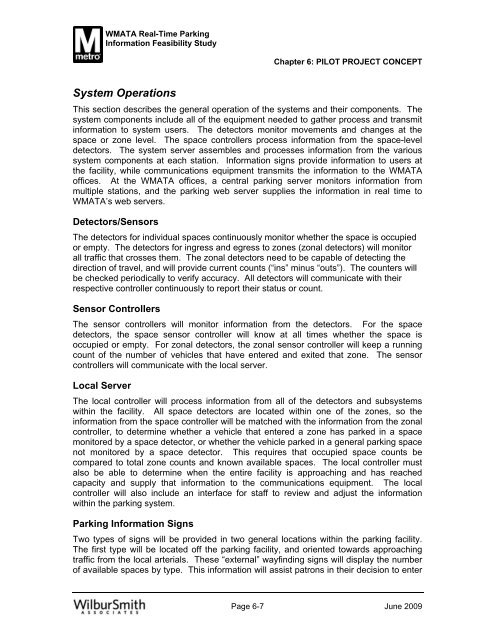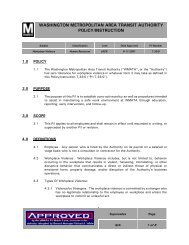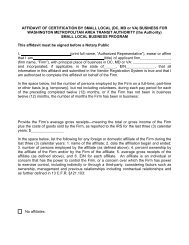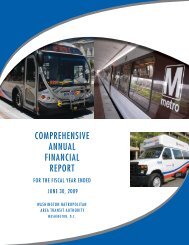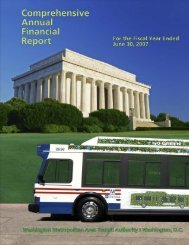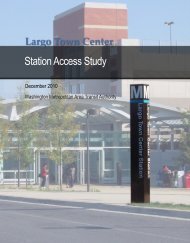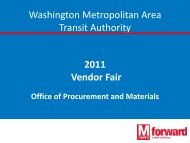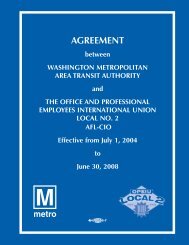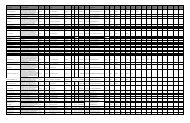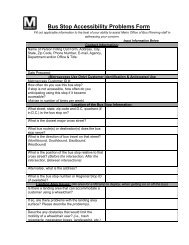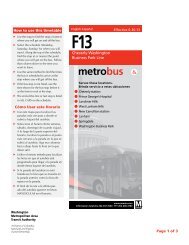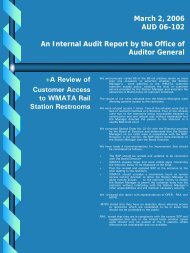feasibility study of real time parking information at ... - WMATA.com
feasibility study of real time parking information at ... - WMATA.com
feasibility study of real time parking information at ... - WMATA.com
Create successful ePaper yourself
Turn your PDF publications into a flip-book with our unique Google optimized e-Paper software.
<strong>WMATA</strong> Real-Time Parking<br />
Inform<strong>at</strong>ion Feasibility Study<br />
Chapter 6: PILOT PROJECT CONCEPT<br />
System Oper<strong>at</strong>ions<br />
This section describes the general oper<strong>at</strong>ion <strong>of</strong> the systems and their <strong>com</strong>ponents. The<br />
system <strong>com</strong>ponents include all <strong>of</strong> the equipment needed to g<strong>at</strong>her process and transmit<br />
<strong>inform<strong>at</strong>ion</strong> to system users. The detectors monitor movements and changes <strong>at</strong> the<br />
space or zone level. The space controllers process <strong>inform<strong>at</strong>ion</strong> from the space-level<br />
detectors. The system server assembles and processes <strong>inform<strong>at</strong>ion</strong> from the various<br />
system <strong>com</strong>ponents <strong>at</strong> each st<strong>at</strong>ion. Inform<strong>at</strong>ion signs provide <strong>inform<strong>at</strong>ion</strong> to users <strong>at</strong><br />
the facility, while <strong>com</strong>munic<strong>at</strong>ions equipment transmits the <strong>inform<strong>at</strong>ion</strong> to the <strong>WMATA</strong><br />
<strong>of</strong>fices. At the <strong>WMATA</strong> <strong>of</strong>fices, a central <strong>parking</strong> server monitors <strong>inform<strong>at</strong>ion</strong> from<br />
multiple st<strong>at</strong>ions, and the <strong>parking</strong> web server supplies the <strong>inform<strong>at</strong>ion</strong> in <strong>real</strong> <strong>time</strong> to<br />
<strong>WMATA</strong>’s web servers.<br />
Detectors/Sensors<br />
The detectors for individual spaces continuously monitor whether the space is occupied<br />
or empty. The detectors for ingress and egress to zones (zonal detectors) will monitor<br />
all traffic th<strong>at</strong> crosses them. The zonal detectors need to be capable <strong>of</strong> detecting the<br />
direction <strong>of</strong> travel, and will provide current counts (“ins” minus “outs”). The counters will<br />
be checked periodically to verify accuracy. All detectors will <strong>com</strong>munic<strong>at</strong>e with their<br />
respective controller continuously to report their st<strong>at</strong>us or count.<br />
Sensor Controllers<br />
The sensor controllers will monitor <strong>inform<strong>at</strong>ion</strong> from the detectors. For the space<br />
detectors, the space sensor controller will know <strong>at</strong> all <strong>time</strong>s whether the space is<br />
occupied or empty. For zonal detectors, the zonal sensor controller will keep a running<br />
count <strong>of</strong> the number <strong>of</strong> vehicles th<strong>at</strong> have entered and exited th<strong>at</strong> zone. The sensor<br />
controllers will <strong>com</strong>munic<strong>at</strong>e with the local server.<br />
Local Server<br />
The local controller will process <strong>inform<strong>at</strong>ion</strong> from all <strong>of</strong> the detectors and subsystems<br />
within the facility. All space detectors are loc<strong>at</strong>ed within one <strong>of</strong> the zones, so the<br />
<strong>inform<strong>at</strong>ion</strong> from the space controller will be m<strong>at</strong>ched with the <strong>inform<strong>at</strong>ion</strong> from the zonal<br />
controller, to determine whether a vehicle th<strong>at</strong> entered a zone has parked in a space<br />
monitored by a space detector, or whether the vehicle parked in a general <strong>parking</strong> space<br />
not monitored by a space detector. This requires th<strong>at</strong> occupied space counts be<br />
<strong>com</strong>pared to total zone counts and known available spaces. The local controller must<br />
also be able to determine when the entire facility is approaching and has reached<br />
capacity and supply th<strong>at</strong> <strong>inform<strong>at</strong>ion</strong> to the <strong>com</strong>munic<strong>at</strong>ions equipment. The local<br />
controller will also include an interface for staff to review and adjust the <strong>inform<strong>at</strong>ion</strong><br />
within the <strong>parking</strong> system.<br />
Parking Inform<strong>at</strong>ion Signs<br />
Two types <strong>of</strong> signs will be provided in two general loc<strong>at</strong>ions within the <strong>parking</strong> facility.<br />
The first type will be loc<strong>at</strong>ed <strong>of</strong>f the <strong>parking</strong> facility, and oriented towards approaching<br />
traffic from the local arterials. These “external” wayfinding signs will display the number<br />
<strong>of</strong> available spaces by type. This <strong>inform<strong>at</strong>ion</strong> will assist p<strong>at</strong>rons in their decision to enter<br />
Page 6-7 June 2009


